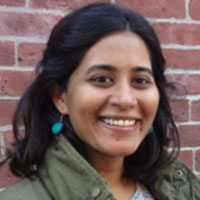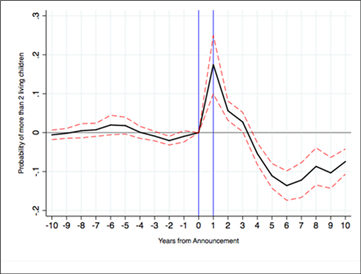Some Indian states debar individuals with more than two children from contesting local elections. This column finds that while the law has significantly reduced fertility among the general population in those states, it has worsened the sex ratio at birth among upper-caste families. It suggests that Indians have strong local leadership aspirations, and that policies altering access to political power can effect social change.
India is the world’s second most populous country, and home to a third of the world’s poorest 1.2 billion people. Fertility reduction has, therefore, always been a priority for Indian policymakers. With this in mind, starting with Rajasthan in 1992, 11 Indian states imposed a ‘two-child limit’ that prevents people with more than two children from contesting Panchayat elections at the village, block and district levels. Four of these states (Haryana, Himachal Pradesh, Madhya Pradesh and Chhattisgarh) eventually repealed the law in 2005-06, but it remains in effect in the other seven states (Rajasthan, Andhra Pradesh, Orissa, Maharashtra, Uttarakhand, Gujarat and Bihar)1. In all these states, a one-year grace period was allowed after the announcement of the law, during which households could have additional children (making their total number of children more than two) and still remain eligible for Panchayat elections. However, for households with two or more children by the end of the grace period, having an additional child thereafter led to disqualification. Households with fewer than two children by the end of the grace period were similarly limited to a maximum of two children afterwards to remain eligible for election.
The two-child limit affects a large number of Indian citizens. Seven of the states where the two-child limit was active during 1992-2006, had a total of 912,597 seats across all three tiers of the Panchayat system in 2004. Assuming three prospective candidates per seat and 30% of a state’s population being of childbearing age (about 102 million people)2, as much as 2.7% of the childbearing population in these states was directly affected by the norm. Thus, an analysis of the impact of this law is extremely relevant from a policy perspective.
Two-child limit for local politicians reduces fertility
Using data from the National Family Health Survey (NFHS) and the District Level Household Survey (DLHS), we examine the fertility behaviour of a random sample of 511,542 women and 1,261,711 births from seven “treatment” states3 where the law was initially implemented and eleven “control” states4 where the law was never enacted, over the period 1973-2006 (Anukriti and Chakravarty 2014)5 We essentially compare fertility outcomes for women in treatment states before and after the announcement of the law, relative to similar women in control states. The post-announcement period in our sample ranges from four years for Maharashtra to 13 years for Rajasthan and Orissa.
We find that, on average, women in treatment states with two children prior to the announcement of the norm are 6.25% less likely to have a third child after it was announced.6 However, this decline is not uniform across all post-announcement years. As Figure 1 depicts, during the grace period, we observe a 17.9 percentage point increase in the likelihood of more than two births, which then declines in subsequent years. This pattern suggests that households are adjusting marginal fertility to take advantage of the exempt period, while remaining eligible for future elections.
Figure 1. Probability of more than two living children, before and after the announcement
Women who had one child before the announcement also show a significant decline in the probability of a second birth post-announcement (relative to pre-announcement years and control states). This decrease likely reflects a delay in the second birth7. Since these one-child families cannot have a third birth after the one-year grace period if they wish to remain eligible for future elections, they may be more likely to practice sex-selection for their second child if son preference is sufficiently strong. Consequently, the limit may increase the time between their first and the second birth (in addition to decreasing completed fertility). To test if this is true, we examine the effect of the two-child limit on the sex ratio of second births.
Two-child limit for local politicians worsens sex ratio
Fertility decline in India and other developing countries with a high societal preference for sons over daughters has been shown to make the sex ratio more male-biased (Anukriti 2014, Ebenstein 2010, Jayachandran 2014). We therefore also investigate if the two-child limit induces any changes in the sex-selection behaviour of households. Exploiting the fact that the gender of the first-born child in India is plausibly random and exogenous, and the well-documented finding that second-born children are much more likely to be male if the first child is a girl, especially for upper-castes (Bhalotra and Cochrane 2010), we examine how the two-child limit affect the sex ratio of second births based on the sex of the first child and caste.
We find that second births in upper-caste households with first-born daughters (relative to those with a first-born son) in treatment states are 3.07 percentage points more likely to be male after announcement of the law than previously, and as compared to the control states. This represents a more than four-fold increase in the likelihood of a male second birth amongst these families as a result of the limit. There is, however, no visible change in the sex ratio of second births in upper-caste families if the first child, born pre-announcement, is a boy. Irrespective of the sex of the first child, we find no effects on the sex ratio of second births amongst lower-caste families. These findings suggest that the law induces upper-caste families to increase sex-selection for the second birth to ensure that they have at least one son, without sacrificing future eligibility for political office.
What’s the story?
The stated rationale for the two-child limit is that it will lower fertility via a “role-model effect”, as citizens in the constituency will emulate their Panchayat leaders. It is reasonable to expect that such an effect would require a period of time to materialise - people will observe their leaders, notice their smaller family size (and sex-selective behaviour), and then change their own fertility decisions. Given that it usually takes nine months to have a child, we would expect at least a year or two to pass before fertility declines visibly. Our results, however, first show an immediate increase in fertility during the grace period, and then a decline. This pattern cannot be explained by a role-model effect.
A mechanism that more plausibly explains our results is aspirations for local leadership positions. The pattern of the fertility effect and the speed at which it occurs is potentially because people wish to be eligible for elections themselves, rather than their learning from already elected role models. Our finding that the effects are stronger for the more politically dominant upper-caste households further supports the aspirations channel.
Policy takeaways
To our knowledge, this is the first instance where a restriction on potential access to political power has had such a profound demographic impact in a large developing country. Our results imply that, unlike what is often assumed or observed in previous studies (Example, Ray 2006, Bernard et al. 2011), Indian citizens strongly aspire to effect change in their lives by holding political office. Our findings also suggest that policies that alter incentives for potential access to local leadership positions can be promising avenues for social change. Unfortunately, however, the adverse effects on sex ratios also show that Indian policymakers continue to ignore societal bias against female children while designing population programmes. Policy initiatives should, therefore, be designed with gender implications in mind so as to prevent unintended consequences such as the ones we have outlined.
Notes:
- Bihar and Uttarakhand have adopted the law for municipal elections, but not for Panchayat elections.
- The range of state population shares aged 20-39 years in the 2001 Census of India is 30-35%.
- Due to data limitations we estimate the impact for only seven states: Rajasthan, Haryana, Andhra Pradesh, Orissa, Himachal Pradesh, Madhya Pradesh (including Chhattisgarh) and Maharashtra.
- Due to data limitations, the control states comprise all other Indian states except Goa and seven northeastern states (Arunachal Pradesh, Manipur, Meghalaya, Mizoram, Nagaland, Sikkim and Tripura).
- The year 2006 is the latest year for which we have data from NFHS. We restrict our sample to women who were married within 20 years prior to the year of survey. This results in 1973 being the earliest year in our sample.
- The baseline figure – which is the average probability of a third birth in treatment states before the announcement of the law, and in control states (where the law was never enacted) – is 8%.
- On average, each abortion delays the next birth, at a minimum, by one year post conception; abortion and re-conception take time.
Further Reading
- Anukriti, S (2014), ‘The Fertility-Sex Ratio Trade-off: Unintended Consequences of Financial Incentives’, IZA Discussion Paper 8044.
- Anukriti, S and A Chakravarty (2014), “Fertility Limits on Local Politicians in India”.
- Beaman, Lori, Esther Duflo, Rohini Pande and Petia Topalova (2012), “Female Leadership Raises Aspirations and Educational Attainment for Girls: A Policy Experiment in India”, Science, Vol. 335, No. 6068, pp. 582-586.
- Bernard, T, S Dercon and AT Taffesse (2011), “Beyond Fatalism - An Empirical Exploration of Self-Efficacy and Aspirations Failure in Ethiopia”, CSAE Working Paper No. 2011-3.
- Bhalotra, S and T Cochrane (2010), ‘Where Have All the Young Girls Gone? Identification of Sex-Selection in India’, IZA Discussion Paper No. 5381.
- Ebenstein, Avraham (2010), “The “Missing" Girls of China and the Unintended Consequences of the One Child Policy”, Journal of Human Resources, 45, 87–115.
- Jayachandran, S (2014), ‘Fertility Decline and Missing Women’, NBER Working Paper 20272.
- Ray, D (2006), ‘Aspirations, Poverty, and Economic Change’, in What Have We Learnt About Poverty, Banerjee, A, R Bénabou, and D Mookherjee (eds.), Oxford University Press.




 02 March, 2015
02 March, 2015 






By: Ganapathi 08 February, 2021
If the second delivery was twins then the person eligible or not